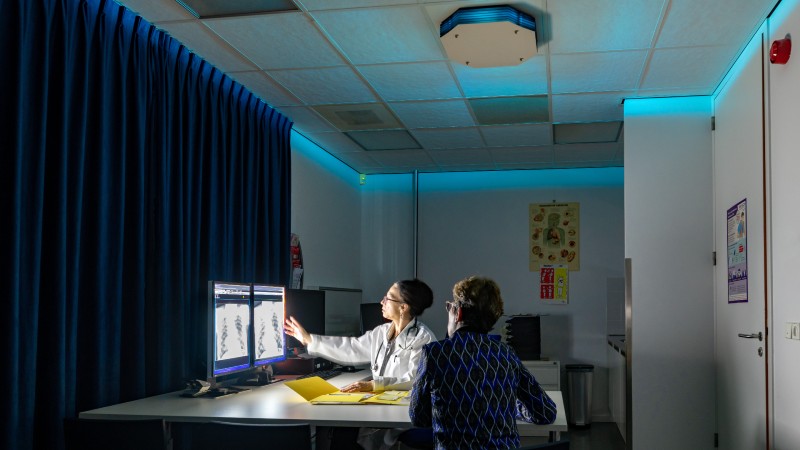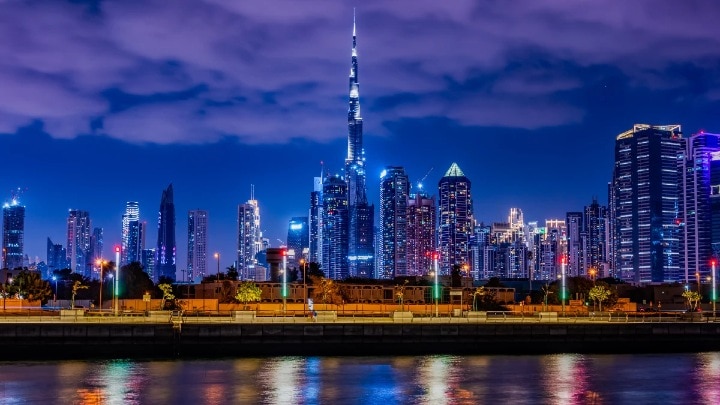April 20, 2022
As we learn to live with the Covid-19 pandemic, UV-C disinfection technologies can help
Covid-19 is here to stay. As our societies begin to open up again, we must learn to do one thing: live with the new normal. But this is difficult when cases remain high and vaccine uptake declines. We need to introduce technologies and policies that work to strengthen the protections offered by masks, social distancing, and jabs without replacing them entirely.
The obvious solution to living with an airborne disease is ventilation, but this can be energy-inefficient and costly, with heating bills rising as schools and offices are forced to keep windows open to encourage airflow. But because we spend much of our time living, working, and socializing indoors, buildings must be both healthy and efficient to reduce the transmission of infectious diseases. Clearly, we must improve ventilation through new engineering techniques—and that’s where UV-C comes in.
Ultraviolet-C is a type of radiation that breaks down the DNA and RNA of microorganisms, including viruses and bacteria, and renders them effectively harmless. The technology is a well-established method of air, water, and surface disinfection that has been offered commercially by Signify (formerly Philips Lighting) for decades. However, its true power and potential has been widely recognized only since the COVID-19 pandemic.
Research conducted in 2020 by the National Emerging Infectious Diseases Laboratories (NEIDL) at Boston University found that Signify’s UV-C light sources reduced SARS-CoV-2 virus infectivity on a surface to below detectable levels in as few as 9 seconds.1
“Given the potential of the technology to aid the fight against the coronavirus, Signify will not keep the technology for its exclusive use but make it available to other lighting companies.” said Eric Rondolat, CEO of Signify.
Signify UV-C disinfection chambers and lamps can disinfect objects as small as handheld supermarket scanners and as large as entire buses. UV-C upper air disinfection luminaires can inactivate the virus in the upper air while people are present in the room, with features designed to shield them from potentially harmful radiation.
Ultimately, this means that we can bring back face-to-face teaching, business, and play.
Recently, the Royal Theater Carré in Amsterdam and the Theater De Ruchte in Someren have installed UV-C technology and are now welcoming patrons to public space in which they can feel confident and safe. In the Royal Theater Carré, 75 Philips UV-C upper air luminaires disinfect the building’s foyer, dressing rooms, and offices, while the Theater De Ruchte is adding another 20 luminaires to an existing pilot installation.
“We are just as happy as our guests and performers to be open again,” said Thomas Groen, manager of sales and partnerships at Royal Theater Carré. “Among other measures, these UV-C luminaires will minimize the risk of infection for our guests, performers, and our colleagues.”
Air changes per hour (ACH) is the term most commonly used to refer to the amount of outside air that needs to be introduced into an interior environment for proper ventilation. For offices and schools, the recommended ventilation level to improve ventilation and overall air quality is up to 2 ACH. However to effectively remove viruses the recommended ventilation level is 20 ACH.
Standard HVAC systems can be uncomfortable and costly as is, and the energy required to bring their performance up to 20 ACH would be vast. UV-C disinfection upper air luminaries overcome these limitations, disinfecting the environment and delivering the required equivalent to 20 ACH in a quiet, comfortable, unobtrusive, and energy-efficient manner.

“I think we should use UV-C disinfection equipment more broadly,” said Roxanna van Nispen-Dobrescu, a pulmonologist at GGD Breda, the Dutch city’s municipal health service. “Before we began to use UV-C devices, some of our staff would get infected with TB by our clients. We haven’t seen any infections since we installed the luminaires as a preventative measure more than ten years ago.”
UV-C should—and can—complement other disease-deterrent technologies and measures. It may even increase vaccine uptake, as it can encourage individuals who may be reluctant to visit vaccinations sites for fear of catching the disease. “Some of our clients are hesitant to come in as they’re afraid of getting infected by harmful viruses or bacteria during their visit,” said Liesbeth Huizer, a medical technician at GGD Rotterdam, in the Netherlands.
UV-C lighting “really helps reassure them,” she added. “I’m surprised that even one and a half years into this pandemic, we’re not making broader use of a technology that we have been using for 20 years and which has proven itself against TB and SARS CoV-2. It’s such an obvious measure.”
Footnotes:
1 Nadia Storm et al., Rapid and complete inactivation of SARS-CoV-2 by ultraviolet-C irradiation, 2020, https://www.nature.com/articles/s41598-020-79600-8. The UV-C irradiance used in this study was 0.849 mW/cm2.
For editorial enquiries:
Signify Global Integrated Communications
Neil Pattie
Tel: + 31 6 15 08 48 17
Email: neil.pattie@signify.com
Signify (Euronext: LIGHT) is the world leader in lighting for professionals, consumers and the Internet of Things. Our Philips products, Interact systems and data-enabled services, deliver business value and transform life in homes, buildings and public spaces. In 2023, we had sales of EUR 6.7 billion, approximately 32,000 employees and a presence in over 70 countries. We unlock the extraordinary potential of light for brighter lives and a better world. We have been in the Dow Jones Sustainability World Index since our IPO for seven consecutive years and have achieved the EcoVadis Platinum rating for four consecutive years, placing Signify in the top one percent of companies assessed. News from Signify can be found in the Newsroom, on X, LinkedIn and Instagram. Information for investors is located on the Investor Relations page.


December 17, 2024
Transforming Dubai’s iconic buildings with connected lighting from Signify